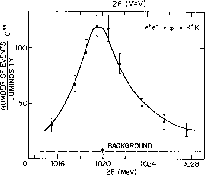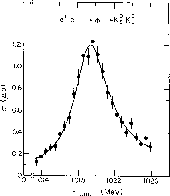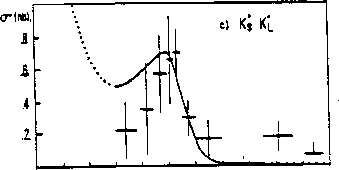


Next: 5 Nucleon form factors
Up: 4 Pseudoscalar form factors
Previous: 4.1 Pion form factor
The threshold for kaon pair production in  -machines is just
below the
-machines is just
below the  -peak. Therefore, the quite good data already available for
-peak. Therefore, the quite good data already available for
 should be considerably improved in Daphne. They
follow, as expected, the
should be considerably improved in Daphne. They
follow, as expected, the  Breit-Wigner excitation curve, as
schematically shown in Figs.(3) and (4).
Some data for higher
Breit-Wigner excitation curve, as
schematically shown in Figs.(3) and (4).
Some data for higher  -values are also
existing above the
-values are also
existing above the  -peak, where
-peak, where  is found to be larger
than
is found to be larger
than  (see Figs.(5) and (6)).
Further details can be seen in the compilations
[1] and [2], as well as in their
references to original work.
(see Figs.(5) and (6)).
Further details can be seen in the compilations
[1] and [2], as well as in their
references to original work.

Figure 3: Exitation curves for the  resonance decaying into
resonance decaying into
 .
.

Figure 4: Cross-section for  .
.
A few determinations of the kaon charge radii are also available. They
lead to [10]

and to the difference [6]  , as qualitatively discussed when dealing with
the physical meaning of these charge-radii.
, as qualitatively discussed when dealing with
the physical meaning of these charge-radii.
The vector part of the  decays gives further information on the
related
decays gives further information on the
related  transition form factor. Indeed, from the PDG
compilation one deduces [11]
transition form factor. Indeed, from the PDG
compilation one deduces [11]

while Sirlin's theorem [9], which is valid up to
first order in SU(3) breaking, predicts
 .
The good agreement with the above values adds some confidence to the
whole set of data and their interpretation.
.
The good agreement with the above values adds some confidence to the
whole set of data and their interpretation.

Figure 5: The  e.m. form factor as a function of energy.
e.m. form factor as a function of energy.

Figure 6: The  e.m. form factor as a function of energy.
e.m. form factor as a function of energy.
Carlos E.Piedrafita
 -machines is just
below the
-machines is just
below the  -peak. Therefore, the quite good data already available for
-peak. Therefore, the quite good data already available for
 should be considerably improved in Daphne. They
follow, as expected, the
should be considerably improved in Daphne. They
follow, as expected, the  Breit-Wigner excitation curve, as
schematically shown in Figs.(3) and (4).
Some data for higher
Breit-Wigner excitation curve, as
schematically shown in Figs.(3) and (4).
Some data for higher  -values are also
existing above the
-values are also
existing above the  -peak, where
-peak, where  is found to be larger
than
is found to be larger
than  (see Figs.(5) and (6)).
Further details can be seen in the compilations
[1] and [2], as well as in their
references to original work.
(see Figs.(5) and (6)).
Further details can be seen in the compilations
[1] and [2], as well as in their
references to original work.

 resonance decaying into
resonance decaying into
 .
. 
 .
. 
 , as qualitatively discussed when dealing with
the physical meaning of these charge-radii.
, as qualitatively discussed when dealing with
the physical meaning of these charge-radii.
 decays gives further information on the
related
decays gives further information on the
related  transition form factor. Indeed, from the PDG
compilation one deduces [
transition form factor. Indeed, from the PDG
compilation one deduces [
 .
The good agreement with the above values adds some confidence to the
whole set of data and their interpretation.
.
The good agreement with the above values adds some confidence to the
whole set of data and their interpretation.

 e.m. form factor as a function of energy.
e.m. form factor as a function of energy. 
 e.m. form factor as a function of energy.
e.m. form factor as a function of energy.